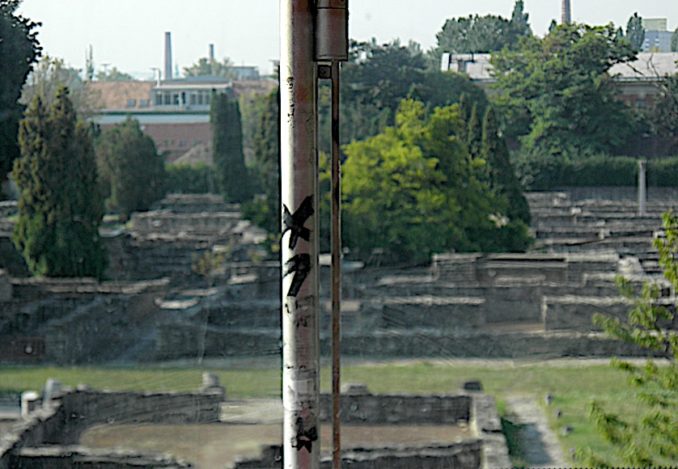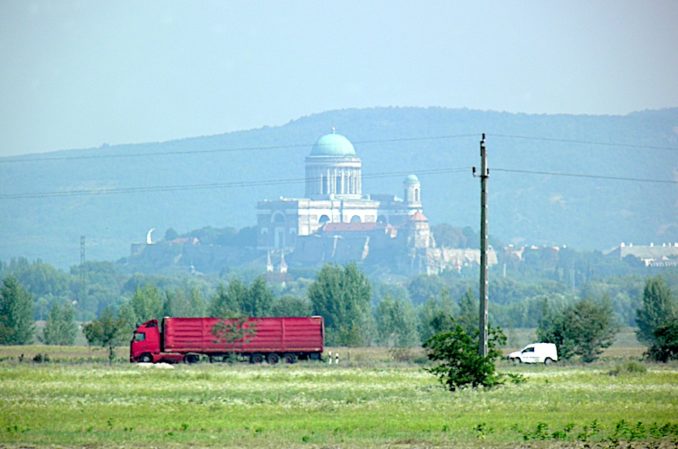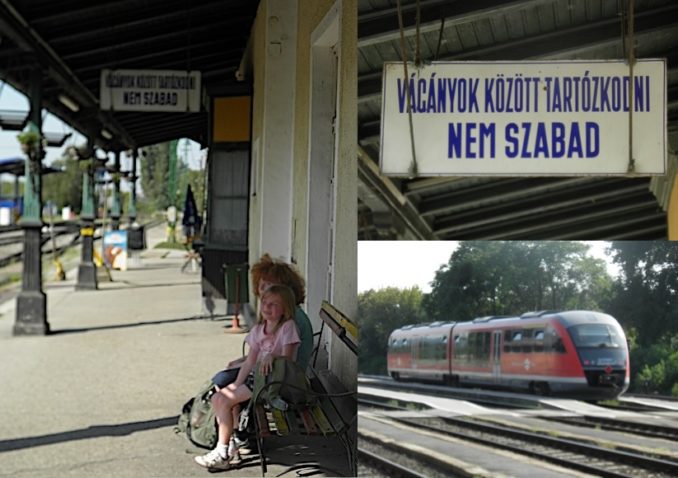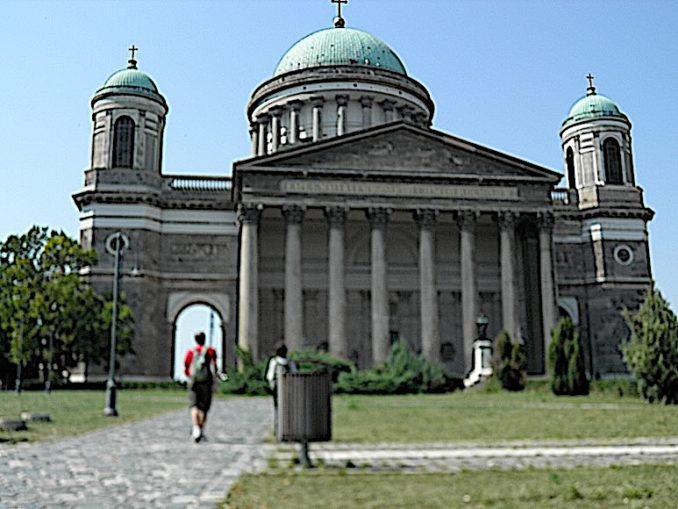
Peter Hitchens at debate on Eastern Europe,
Nigel Luckhurst – Licence CC BY-SA 4.0
I’ve been following Daily Mail columnist and author Peter Hitchens – literally. The surprise being we only recently fell into correspondence. Both of us are keen on railways and church, enjoyed minor public school and endured embarrassing new universities and trips to the Eastern Bloc during the Cold War. And we felt obliged to return as the Iron Curtain rose from Stetin in the Baltic to Trieste in the Adriatic.
For the Mail, Peter despatched from Sevastopol, now debatable Crimean lands claimed by both Russia and Ukraine. Myself? I returned to two of my old stomping grounds of Czechoslovakia and Hungary. The family trudged along too. We shall return to Peter and our correspondence, but first, no return to Hungary or telling of the tale afterwards can neglect an interesting day trip from Budapest.
I must describe a boiling hot August day a frighteningly swift-passing twenty-one years after the end of Communism and twenty-four years after my time there. Yes, I was present only months before the demise. Somewhere, there is a dusty report upon a neglected shelf predicting Communism to last a thousand years rather to than struggle to last another 1,000 days. My initials are on the back page, my fingerprints all over the immaculate but ill-informed prose.
Back to a boily morning in early 2010s Budapest. Within the crumbling splendour of Nyugati station’s ticket office, electric fans try and fail to cool the queues. On the other side of the ornate grills and marble surfaces, bowls of water aside damp flannels struggled to soothe the staff.

© Google Street View 2024, Google.com
Don’t be fooled by all this talk of ‘Nyugati’. In the impenetrable local lingo it means ‘west’. But the station sits in the east of the city, with Mrs AWS, me and the children trusting in the iron road that emerges from the Eifeell Company-built 1877 edifice, to take us north.
We are purchasing our day returns for a trip of only 23 miles – if travelled in a line as straight as a migrating stork. The land-bound train stretches the distance to 32. According to the timetable, it will be 90 minutes by rail, at a stately 21 mph. However, our trip took longer due to engineering work, more of which later.
For those unfamiliar with the Hungarian capital, Budapest is a city separated in two as the Danube River flows from north to south. Buda is the hilly half to the west. Pest (pronounced ‘Pesssshhht’)is the flat bit to the east. Nyugati preens herself in a corner of her own Pest square interrupting the great radial boulevard of Terez Korut. Departing the station, our train runs behind Budapest Zoo and the famous Széchenyi Thermal Baths towards overgrown land that one assumes to be long abandoned railway sidings.
Confirming the suspicion, we swing east at a junction and around the back of some railway roundhouses, part of which is a fordítókorong surrounded by a collection of preserved engines. With ‘fordítókorong’ the Hungarians are at it again. What we would call a turntable, the Hungarian refers to as a ‘translation disc’. I can just about see what they mean. Next, even those disinterested in railways will be impressed by the two-thirds-of-a-mile-long Ujpest rail viaduct which carries us across the Danube. At this point, Puffins are encouraged to spy out of the left side of the train and take in some Roman remains.

© Always Worth Saying 2024, Going Postal
This is what’s left of classical Budapest, the fortress town of Aquinium, established in about 100 AD, a few decades after the legions conquered the local Celtic tribes. A look to the right will allow a glimpse of an amphitheatre.
The rails having avoided the worst of hilly Buda, we’re already in the countryside with strip-farm small holdings on either side of the line. Our luck doesn’t hold. After the halfway point of Pilisvorosvar, we’re caught out by the northern part of the Buda Hills, albeit cleverly surveyed at their narrowest point by the railway engineers. Hair pins curving through forest lead to flat lands closer to the Danube.
At a junction in a place called Tabor, we head north-northeast and shadow the route of the great river. By now, our destination is impossible to miss, topping as it does a Danube hillside. We are approaching Esztergom, the ecclesiastical capital of Hungary, which boasts an unmissable 300-foot-high basilica on the top of a hill.

© Always Worth Saying 2024, Going Postal
These days, it also enjoys a car factory — yes, a car factory. Magyar Suzuki Corporation was founded in 1991 as a joint venture between the Hungarian government and Suzuki Motor Corporation of Japan. Suzuki vehicles are made here for both the domestic and international markets. Quick off the mark at the end of the Cold War, production began in 1992, and since then Magyar Suzuki has become one of Hungary’s leading automotive manufacturers.
Not a rehash of old sheds bashing tin into Motoneps or Pannonia’s (Pannonia being the old Roman word for Hungary), Magyar Suzuki’s Esztergom plant is a state-of-the-art manufacturing facility equipped with modern production lines and technologies. Handily beside the railway line, judging by the surrounding parking lots, during our visit they were churning out Suzuki Swifts, some of which were badged as Vauxhall Agilas.
Close to the car factory sits Esztegom railway station. Warning: the terminus is a long-feeling mile-and-a-half hike from the town centre and basilica. Not an unpleasant walk, as it allows a glimpse of the single-story dwellings and clay-tiled roofs of small-town Hungary. Low hedges and rows of saplings squeeze into pencil-straight avenues lined with narrow pavements. For a more shaded stroll, head down a side street and walk along the banks of the Lesser Danube, a man-made channel bound by a simple promenade, where the locals tie their boats.
No matter what the route, all paths lead to Castle Hill and the impressive basilica sitting atop. Judging by Street View, the town’s been given a lick of paint since our family trip in 2011, let alone since the end of the Cold War. That’s also true of the railway. Work began only a few months before our visit under a project financed by the EU. New stations are in place on the line from Budapest, and the track is now electrified and doubled between Budapest and Pilisvorosvar.
Again, judging by Street View, the station building is renovated, and the platforms improved. A giant car park sits where neglected sidings once slept while being returned to nature. Am I allowed to say I preferred it when it was a bit neglected?

© Always Worth Saying 2024, Going Postal
A more welcome change Puffins will have noticed is the subsequent invention of the smartphone. Gone are the days when cheapo digital cameras ruined your holidays with blurry photos and daft colours (vivid reds and greens, a speciality).
As for the history of the township, nestled along the picturesque bend of the Danube River in northern Hungary, Esztergom boasts a rich history spanning over a millennium. As one of the oldest towns in Hungary, Esztergom has played a significant role in the country’s political, religious, and cultural development. In ancient times, it was settled by Celtic tribes. However, its prominence began to rise during the Roman Empire’s rule when known as Solva. As a key military and economic hub, Solva flourished with the establishment of forts and trade routes along the Danube.
With the arrival of Christianity in the region, Esztergom emerged as a pivotal centre of the faith. In the 10th century, it became the seat of the Hungarian monarchy and the residence of the country’s first king, St. Stephen (István), who converted Hungary to Christianity. Esztergom’s significance as a political and ecclesiastical capital continued throughout the medieval period, witnessing the coronations of many Hungarian kings and serving as the headquarters of the Hungarian Catholic Church.
During the 16th century, Esztergom faced tumultuous times with the Ottoman invasion. The town fell under Ottoman control in 1543 after a prolonged siege, leading to the decline of its status as a major political and religious centre. However, Esztergom remained a symbol of resistance against Ottoman rule, and efforts were made to reclaim it by the Habsburgs and Hungarian forces. The 18th and 19th centuries brought a period of revival and reconstruction. The town underwent significant architectural developments, including the construction of the monumental Esztergom Basilica, one of the largest churches in Hungary and a symbol of the town’s religious heritage.
Officially known as the Primatial Basilica of the Blessed Virgin Mary Assumed Into Heaven and St Adalbert, the Basilica stands atop Castle Hill, overlooking the Danube, and remains a remarkable example of Hungarian neoclassical architecture.

© Always Worth Saying 2024, Going Postal
Construction of the Basilica began in the 19th century, following the destruction of the previous cathedral during the Ottoman occupation. Designed by architect József Hild, the Basilica is in a neoclassical style with Baroque elements, reflecting the architectural trends of the era. Its construction took several decades to complete, with various architects and craftsmen contributing to its design and execution.
The location atop Castle Hill offers panoramic views of the Danube River and the surrounding countryside, adding to its majestic presence. Its massive dome, towering over 100 meters above the ground, makes it the second tallest building in Hungary and one of the largest churches in Central Europe.
One of the Basilica’s most impressive features is its interior, which is adorned with exquisite artwork, sculptures and ornate decorations. Visitors are captivated by the intricate details of the high altar, the stunning frescoes adorning the dome and ceilings and the beautiful stained-glass windows illuminating the space in colour. The Basilica also houses a rich collection of religious relics and artefacts, including the Holy Crown of Hungary. We shall have a look inside next time.
To be continued…
© Always Worth Saying 2024


